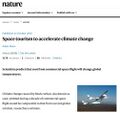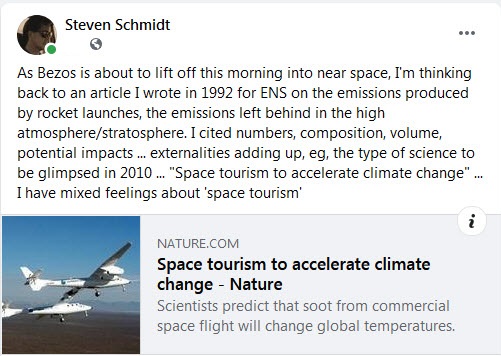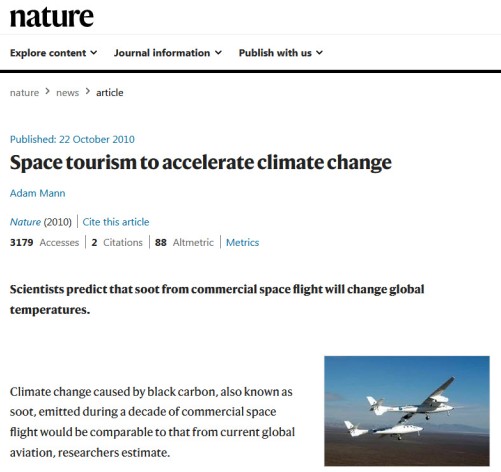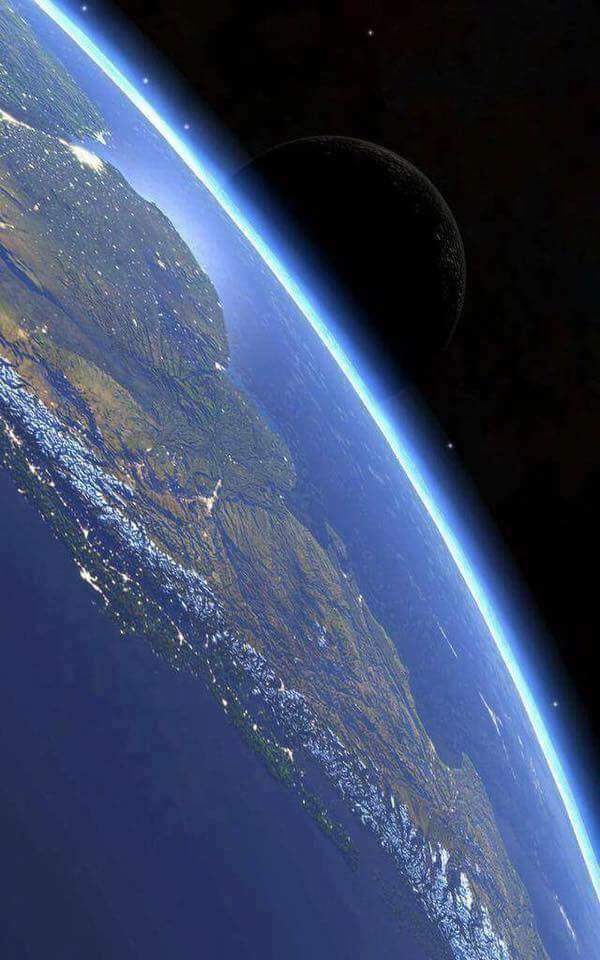File:Space Tourism to Accelerate Climate Change - Nature article Oct 2010.jpg: Difference between revisions
Siterunner (talk | contribs) No edit summary |
Siterunner (talk | contribs) No edit summary |
||
| Line 1: | Line 1: | ||
<big>'''As Space Tourism Takes Off, Questions Need to be Asked'''</big> | |||
July 20, 2021 | |||
'''''Jeff Bezos goes to Space: Blue Origin successfully launches humans into space''''' | |||
: ''Mark Bezos, Jeff Bezos, Oliver Daemen and Wally Funk... the Blue Origin’s New Shepard space crew'' | |||
'''''Space race: What Jeff Bezos, Elon Musk, and Richard Branson are each trying to achieve''''' | |||
'''''Wally Funk makes history as oldest person to launch into space''''' | |||
[[File:Space Tourism and emission-climate questions - July 20, 2021.jpg]] | |||
[[File:Space Tourism to Accelerate Climate Change - Nature article Oct 2010.jpg]] | |||
* https://ui.adsabs.harvard.edu/abs/2010GeoRL..3724810R/abstract | |||
* https://ui.adsabs.harvard.edu/abs/2010GeoRL..3724810R/references | |||
* https://ui.adsabs.harvard.edu/abs/2010GeoRL..3724810R/similar | |||
Read the research article: | |||
<big><big>'''''Space tourism to accelerate climate change'''''</big></big> | |||
Adam Mann et al. | |||
Nature | |||
Article Published / 2010 | |||
'''''Scientists predict that soot from commercial space flight will change global temperatures.''''' | |||
“There are fundamental limits to how much material human beings can put into orbit without having a significant impact.” | |||
''Climate change caused by black carbon, also known as soot, emitted during a decade of commercial space flight would be comparable to that from current global aviation, researchers estimate.'' | |||
''The findings, reported in a paper in press in Geophysical Research Letters1, suggest that emissions from 1,000 private rocket launches a year would persist high in the stratosphere, potentially altering global atmospheric circulation and distributions of ozone.'' | |||
''The simulations show that the changes to Earth's climate could increase polar surface temperatures by 1 °C, and reduce polar sea ice by 5–15%.'' | |||
''"There are fundamental limits to how much material human beings can put into orbit without having a significant impact," says Martin Ross, an atmospheric scientist at the Aerospace Corporation in Los Angeles, California and an author of the study.'' | |||
''Private space flight is a rapidly maturing industry. Spaceport America, a launch site in Las Cruces, New Mexico, opened its first runway on 22 October. During the next three years, companies such as Virgin Galactic, headquartered at Spaceport America, expect to make up to two launches per day for space tourists. Meanwhile, the NASA Authorization Act passed by US Congress in September provides US$1.6 billion in private space-flight investments to develop vehicles to take astronauts and cargo into orbit.'' | |||
''Commercial rockets burn a mixture of kerosene and liquid oxygen. But several private space-flight companies, such as Virgin Galactic, may soon use a more economical 'hybrid' rocket engine that ignites synthetic hydrocarbon with nitrous oxide, says Ross. These hybrid engines emit more black carbon than a kerosene and oxygen engine, he adds.'' | |||
''"Rain and weather wash out these particles from the atmosphere near Earth's surface, but in the stratosphere there isn't any rain and they can remain for 3 to 10 years," says Michael Mills, an atmospheric chemist at the National Center for Atmospheric Research (NCAR) in Boulder, Colorado, and another author of the paper.'' | |||
'''''Soot surprise''''' | |||
''The researchers ran global atmospheric models of an injection of about 600 tonnes of black carbon per year at a single location: Las Cruces. The results showed a soot layer in the stratosphere that stays within 10° latitude of the launch site, says Ross. Furthermore, around 80% of the black carbon remained in the Northern Hemisphere, spreading out to between 25° and 45° northern latitude.'' | |||
; <big><big>'''Earth Science, Environmental Security'''</big></big> | |||
• http://www.greenpolicy360.net/w/New_Definitions_of_National_Security | |||
• http://www.greenpolicy360.net/w/Earth_Science_Vital_Signs | |||
• http://www.greenpolicy360.net/w/Earth_Right_Now | |||
• http://www.greenpolicy360.net/w/Democratization_of_Space | |||
• http://www.greenpolicy360.net/w/Planet_API | |||
• http://www.greenpolicy360.net/w/Category:Earth_Observations | |||
• http://www.greenpolicy360.net/w/OCO-2 | |||
• http://www.greenpolicy360.net/w/Micro-satellites | |||
• http://www.greenpolicy360.net/w/Planet_Labs_Doves_Fly | |||
[[File:Earth-Thin Blue Atmosphere-Moon image - NASA.jpg]] | |||
○ | |||
[[Category:Anthropocene]] | |||
[[Category:Atmospheric Science]] | |||
[[Category:Citizen Science]] | |||
[[Category:Climate Change]] | |||
[[Category:Climate Policy]] | |||
[[Category:Democratization of Space]] | |||
[[Category:Earth360]] | |||
[[Category:Earth Imaging]] | |||
[[Category:Earth Observations]] | |||
[[Category:Earth Science]] | |||
[[Category:Environmental Full-cost Accounting]] | |||
[[Category:Environmental Laws]] | |||
[[Category:Environmental Protection]] | |||
[[Category:Environmental Security]] | |||
[[Category:Environmental Security, National Security]] | |||
[[Category:ESA]] | |||
[[Category:Externalities]] | |||
[[Category:Fossil Fuels]] | |||
[[Category:Global Security]] | |||
[[Category:Global Warming]] | |||
[[Category:Green Graphics]] | |||
[[Category:NASA]] | |||
[[Category:NOAA]] | |||
[[Category:Natural Resources]] | |||
[[Category:New Definitions of National Security]] | |||
[[Category:New Space]] | |||
[[Category:Orbital Perspective]] | |||
[[Category:Planet Citizen]] | |||
[[Category:Planet Citizens]] | |||
[[Category:Planet Scientist]] | |||
[[Category:Planet Citizens, Planet Scientists]] | |||
[[Category:Planetary Science]] | |||
[[Category:Space Science and Space Physics]] | |||
[[Category:Strategic Demands]] | |||
[[Category:ThinBlueLayer]] | |||
[[Category:Threat Multiplier]] | |||
[[Category:US Environmental Protection Agency]] | |||
[[Category:Whole Earth]] | |||
Revision as of 19:35, 20 July 2021
As Space Tourism Takes Off, Questions Need to be Asked
July 20, 2021
Jeff Bezos goes to Space: Blue Origin successfully launches humans into space
- Mark Bezos, Jeff Bezos, Oliver Daemen and Wally Funk... the Blue Origin’s New Shepard space crew
Space race: What Jeff Bezos, Elon Musk, and Richard Branson are each trying to achieve
Wally Funk makes history as oldest person to launch into space
Read the research article:
Space tourism to accelerate climate change
Adam Mann et al.
Nature
Article Published / 2010
Scientists predict that soot from commercial space flight will change global temperatures.
“There are fundamental limits to how much material human beings can put into orbit without having a significant impact.”
Climate change caused by black carbon, also known as soot, emitted during a decade of commercial space flight would be comparable to that from current global aviation, researchers estimate.
The findings, reported in a paper in press in Geophysical Research Letters1, suggest that emissions from 1,000 private rocket launches a year would persist high in the stratosphere, potentially altering global atmospheric circulation and distributions of ozone.
The simulations show that the changes to Earth's climate could increase polar surface temperatures by 1 °C, and reduce polar sea ice by 5–15%.
"There are fundamental limits to how much material human beings can put into orbit without having a significant impact," says Martin Ross, an atmospheric scientist at the Aerospace Corporation in Los Angeles, California and an author of the study.
Private space flight is a rapidly maturing industry. Spaceport America, a launch site in Las Cruces, New Mexico, opened its first runway on 22 October. During the next three years, companies such as Virgin Galactic, headquartered at Spaceport America, expect to make up to two launches per day for space tourists. Meanwhile, the NASA Authorization Act passed by US Congress in September provides US$1.6 billion in private space-flight investments to develop vehicles to take astronauts and cargo into orbit.
Commercial rockets burn a mixture of kerosene and liquid oxygen. But several private space-flight companies, such as Virgin Galactic, may soon use a more economical 'hybrid' rocket engine that ignites synthetic hydrocarbon with nitrous oxide, says Ross. These hybrid engines emit more black carbon than a kerosene and oxygen engine, he adds.
"Rain and weather wash out these particles from the atmosphere near Earth's surface, but in the stratosphere there isn't any rain and they can remain for 3 to 10 years," says Michael Mills, an atmospheric chemist at the National Center for Atmospheric Research (NCAR) in Boulder, Colorado, and another author of the paper.
Soot surprise
The researchers ran global atmospheric models of an injection of about 600 tonnes of black carbon per year at a single location: Las Cruces. The results showed a soot layer in the stratosphere that stays within 10° latitude of the launch site, says Ross. Furthermore, around 80% of the black carbon remained in the Northern Hemisphere, spreading out to between 25° and 45° northern latitude.
- Earth Science, Environmental Security
• http://www.greenpolicy360.net/w/New_Definitions_of_National_Security
• http://www.greenpolicy360.net/w/Earth_Science_Vital_Signs
• http://www.greenpolicy360.net/w/Earth_Right_Now
• http://www.greenpolicy360.net/w/Democratization_of_Space
• http://www.greenpolicy360.net/w/Planet_API
• http://www.greenpolicy360.net/w/Category:Earth_Observations
• http://www.greenpolicy360.net/w/OCO-2
• http://www.greenpolicy360.net/w/Micro-satellites
• http://www.greenpolicy360.net/w/Planet_Labs_Doves_Fly
○
File history
Click on a date/time to view the file as it appeared at that time.
| Date/Time | Thumbnail | Dimensions | User | Comment | |
|---|---|---|---|---|---|
| current | 19:07, 20 July 2021 |  | 501 × 472 (44 KB) | Siterunner (talk | contribs) |
You cannot overwrite this file.
File usage
The following 2 pages use this file:
- Anthropocene
- Atmospheric Science
- Citizen Science
- Climate Change
- Climate Policy
- Democratization of Space
- Earth360
- Earth Imaging
- Earth Observations
- Earth Science
- Environmental Full-cost Accounting
- Environmental Laws
- Environmental Protection
- Environmental Security
- Environmental Security, National Security
- ESA
- Externalities
- Fossil Fuels
- Global Security
- Global Warming
- Green Graphics
- NASA
- NOAA
- Natural Resources
- New Definitions of National Security
- New Space
- Orbital Perspective
- Planet Citizen
- Planet Citizens
- Planet Scientist
- Planet Citizens, Planet Scientists
- Planetary Science
- Space Science and Space Physics
- Strategic Demands
- ThinBlueLayer
- Threat Multiplier
- US Environmental Protection Agency
- Whole Earth


